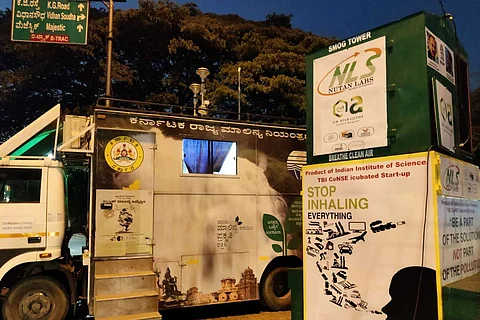

On Monday, Bengaluru got its first smog tower. It was installed at Hudson Circle, near the Bruhat Bengaluru Mahanagara Palike (BBMP) headquarters. This has been done in a bid to reduce air pollution. Similar smog towers made by an Indian Institute of Science(IISc) incubated startup, Nutan Labs, will be deployed at various parts of the city, specifically at heavy traffic junctions, as part of a pilot programme.
Officials, led by BBMP Commissioner Manjunath Prasad (IAS), did a spot inspection of the device on Tuesday. To check the functioning and efficacy of the device, the Karnataka State Pollution Control Board has set up a mobile facility at the spot to study the real-time effects of the smog tower.
According to a statement put out by the company, the device uses nanoparticles to absorb pollutants from the air such as PM 2.5, PM 10, oxides of carbon, sulphur, and nitrogen and can purify 15,000 cubic feet of air every minute. The company claims that it is the world’s most efficient and robust smog tower. Speaking to TNM, HS Nuthan, CEO of Nutan Labs, said that the device uses 11 kW of electricity every hour and costs roughly about Rs 60 lakh. But for this drive, no money has been spent by the BBMP. He said apart from the cost of the device, the smog tower will require varying maintenance costs based on the quality of the ambient air.
While the BBMP is poised to expand the pilot programme, experts are not excited about the smog towers. Aishwarya Sudhir, a Bengaluru-based air quality researcher, said, “Smog towers cannot clean the air beyond a few hundred meters and are unfortunately not a replacement for the required action on the ground.”
She added, “There is a severe problem of road and construction dust across the city and little is being done to bring any of that under control, with summer fast approaching, the situation is likely to get worse, there's little clarity on how the city's clean air action plan is fairing amidst this chaos. And symbolic gestures, I am afraid, won't get us anywhere.”
Madhulika Verma, Communication Consultant at Climate Trends, said, "There is no scientific evidence to prove the effectiveness of smog towers. Its effectiveness if at all, can be restricted to a very small area around them and if the government is projecting smog towers as a solution, then we will require lakhs of such towers spread across the city. The smog tower in Delhi failed to show efficacy, so there is no reason for it to bring miracles in Bengaluru."
While Delhi often gets noticed for its abysmal air quality, a recent Greenpeace Southeast Asia analysis found that Bengaluru has the third-worst air quality among cities in India. The study said while Delhi fared worst with 54,000 estimated deaths due to poor air quality, followed by Mumbai at 25,000 deaths, Bengaluru had 12,000 estimated deaths in 2020.